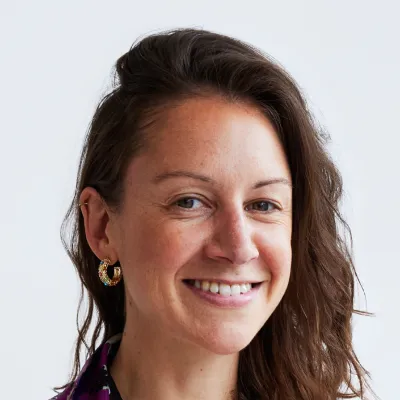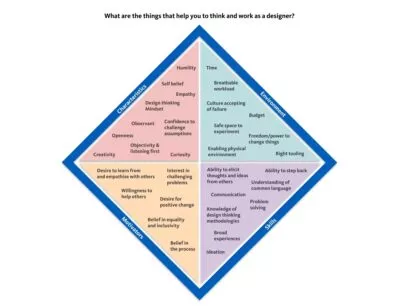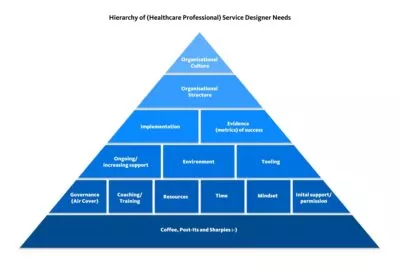27 Jul 2022
Reflections from our workshop: Supporting healthcare professionals to think like service designers
At UX Healthcare 2022 we ran a workshop exploring this idea further, asking ‘What needs to be true in order for healthcare professionals to be able to think and work like service designers?’ Read on to find out what we learnt.
-
Nicola Pritchard
Principal Service Designer

Redesign a healthcare service, and it will meet user needs for a day. Support healthcare professionals to think like service designers, and it will meet user needs for a lifetime.
Service design approaches are becoming commonplace within healthcare because they can help teams to put users at the heart of service improvements; to test, learn and iterate on ideas quickly, and make less costly mistakes. There is so much work to do but not enough service designers available to do the work.
Perhaps the solution is to help healthcare professionals to think like service designers?
We recently trialled an approach with the NHS where we’ve been coaching mental health professionals to apply service design practices to improve physical health outcomes for people with severe mental illness. At UX Healthcare 2022 we ran a workshop exploring this idea further, asking ‘What needs to be true in order for healthcare professionals to be able to think and work like service designers?’ Read on to find out what we learnt.
The problem space
We know from our research that:
- Services are hard to navigate – patients often don’t know where they are in the process or what to expect next
- Patients (particularly when in mental health crisis) are in no fit state to deal with service complexity
- For people who are digitally excluded, there are big impacts of digital transformation within healthcare
- Seldom heard population groups are not being designed for
So how do we fix this? Ideally, we’d take a step back and redesign the end-to-end service. Bring in the service designers!
But…
- Services have challenges trying to access service design professionals and there aren’t enough UCD professionals available to go round
- Local teams are under-resourced and service improvement knowledge is inconsistent
- Service transformation funding is often non-recurrent
- Healthcare professionals are feeling ‘change fatigue’ so can sometimes resist more change
It feels like one solution might be for service designers to shift from doing to coaching to make our impact more sustainable.
We wondered if healthcare professionals were supported to think and work like service designers they could spot and address the problems they encounter on the front line themselves. The high volume of small changes they could make would have a compounding impact on service quality.
Our workshop at UX Healthcare aimed to explore how we might achieve this in reality.
A hierarchy of needs
We first asked, ‘What are the things that enable us to think and work like service designers?’
We felt this was an important exercise because working daily within the world of service design we can take our knowledge and experience for granted, unaware of our privilege. We also work in environments that are designed to foster creativity and collaboration, which is seldom the case for healthcare professionals.
In the workshop, mixed teams of service designers and healthcare professionals shared their thoughts on this – which we’ve summarised in the ‘diamond’ diagram below. It captures what people felt were the key characteristics, environmental factors, motivators, and skills that help us to do what we do. These included having core characteristics like empathy, curiosity and humility, core motivators such as a deep desire to make a positive change for people, and core skills such as broad experiences and problem-solving abilities. And lastly, having an enabling environment around us, which supports us to feel free to experiment and to fail, and a team around us that is willing to champion and buy into service design principles and ways of working.

We then asked people, ‘What needs to be true in order for healthcare professionals to be able to think and work like service designers?’
Borrowing from Maslow’s hierarchy, we armed groups with some example ‘building blocks’ for creating our own bespoke ‘hierarchy of needs’ for healthcare professionals to do service design activities. People came up with a range of ideas for what would be considered foundational – such as organisational support, the right mindset, and motivation to do so. People also considered what would add additional value or support healthcare professionals to enrich their practice and experience – ideas included access to skills development and tools.
One group developed a more comprehensive Maslow-ian pyramid (see below), where many of the building blocks generally came from conditions that are often outside an individual’s control. This included things like time, tools, permission, governance, resources, culture, and structure. In this particular example, only the right mindset featured as a critical building block that the individual would have more control over. Other groups also included other internal factors like personal motivation and critical characteristics such as empathy, echoing some of the key themes from the first exercise.

Key takeaway
The workshop revealed a common perception amongst people in the room that service design is only possible to practice well when there are the right external conditions in place to do so. Armed with the right community of support and the right environment, healthcare professionals have a much greater chance of success, than when going it alone.
In order to support healthcare professionals to think and work like service designers, we have to first look at the conditions in which they work. ‘Have we got the buy-in? The time? The freedom and power to change things?’ With these things, we are much more likely to be able to develop the right skills and competencies, and feel motivated to do so.
The good news is that when asked whether service design is possible to develop and practice in our healthcare system, and something we should strive for, we heard a resounding ‘yes’. It might be a tricky road but it’s a worthwhile effort.
Thank you to all the people who contributed to our workshops, sharing their knowledge and experience to help inform this piece of work. You can take a look at the raw insights from our workshop and our summary diagrams in more detail here on our miro board.
Get in touch to find out how we can help you and your teams to upskill and apply service design principles in your day to day work.



